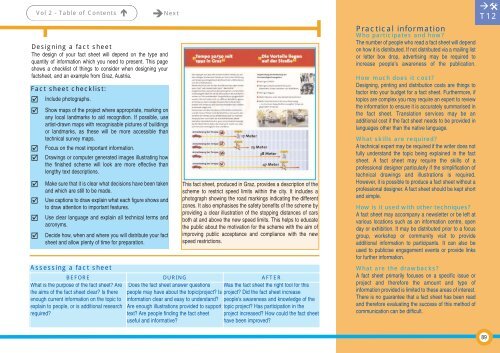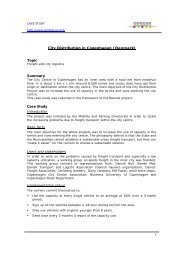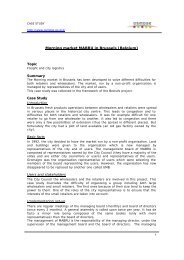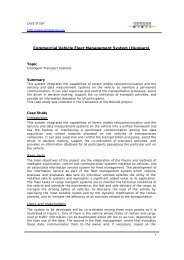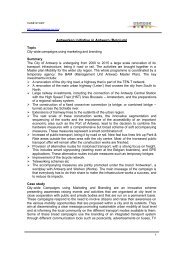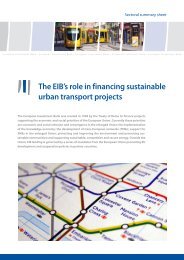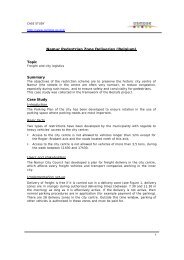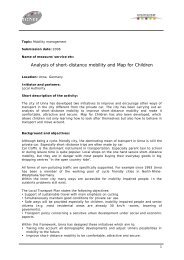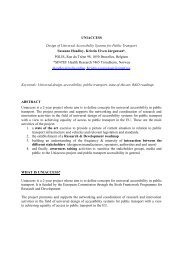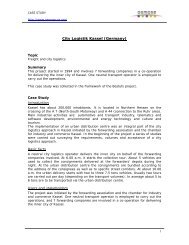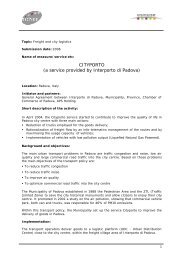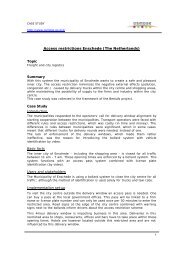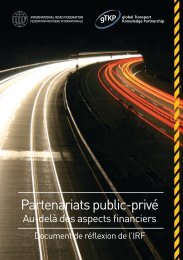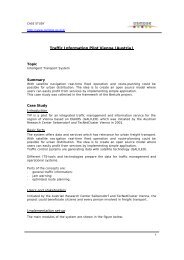Successful transport decision-making - Osmose
Successful transport decision-making - Osmose
Successful transport decision-making - Osmose
Create successful ePaper yourself
Turn your PDF publications into a flip-book with our unique Google optimized e-Paper software.
Vol 2 - Table of Contents Next Practical information<br />
Who participates and how?<br />
Designing a fact sheet<br />
The design of your fact sheet will depend on the type and<br />
quantity of information which you need to present. This page<br />
shows a checklist of things to consider when designing your<br />
factsheet, and an example from Graz, Austria.<br />
Fact sheet checklist:<br />
Include photographs.<br />
<br />
<br />
<br />
<br />
<br />
<br />
<br />
<br />
Show maps of the project where appropriate, marking on<br />
any local landmarks to aid recognition. If possible, use<br />
artist-drawn maps with recognisable pictures of buildings<br />
or landmarks, as these will be more accessible than<br />
technical survey maps.<br />
Focus on the most important information.<br />
Drawings or computer generated images illustrating how<br />
the finished scheme will look are more effective than<br />
lengthy text descriptions.<br />
Make sure that it is clear what <strong>decision</strong>s have been taken<br />
and which are still to be made.<br />
Use captions to draw explain what each figure shows and<br />
to draw attention to important features.<br />
Use clear language and explain all technical terms and<br />
acronyms.<br />
Decide how, when and where you will distribute your fact<br />
sheet and allow plenty of time for preparation.<br />
Assessing a fact sheet<br />
BEFORE DURING AFTER<br />
Does the fact sheet answer questions<br />
people may have about the topic/project? Is<br />
information clear and easy to understand?<br />
Are enough illustrations provided to support<br />
text? Are people finding the fact sheet<br />
useful and informative?<br />
What is the purpose of the fact sheet? Are<br />
the aims of the fact sheet clear? Is there<br />
enough current information on the topic to<br />
explain to people, or is additional research<br />
required?<br />
This fact sheet, produced in Graz, provides a description of the<br />
scheme to restrict speed limits within the city. It includes a<br />
photograph showing the road markings indicating the different<br />
zones. It also emphasises the safety benefits of the scheme by<br />
providing a clear illustration of the stopping distances of cars<br />
both at and above the new speed limits. This helps to educate<br />
the public about the motivation for the scheme with the aim of<br />
improving public acceptance and compliance with the new<br />
speed restrictions.<br />
Was the fact sheet the right tool for this<br />
project? Did the fact sheet increase<br />
people's awareness and knowledge of the<br />
topic project? Has participation in the<br />
project increased? How could the fact sheet<br />
have been improved?<br />
The number of people who read a fact sheet will depend<br />
on how it is distributed. If not distributed via a mailing list<br />
or letter box drop, advertising may be required to<br />
increase people’s awareness of the publication.<br />
How much does it cost?<br />
Designing, printing and distribution costs are things to<br />
factor into your budget for a fact sheet. Furthermore, if<br />
topics are complex you may require an expert to review<br />
the information to ensure it is accurately summarised in<br />
the fact sheet. Translation services may be an<br />
additional cost if the fact sheet needs to be provided in<br />
languages other than the native language.<br />
What skills are required?<br />
A technical expert may be required if the writer does not<br />
fully understand the topic being explained in the fact<br />
sheet. A fact sheet may require the skills of a<br />
professional designer particularly if the simplification of<br />
technical drawings and illustrations is required.<br />
However, it is possible to produce a fact sheet without a<br />
professional designer. A fact sheet should be kept short<br />
and simple.<br />
How is it used with other techniques?<br />
A fact sheet may accompany a newsletter or be left at<br />
various locations such as an information centre, open<br />
day or exhibition. It may be distributed prior to a focus<br />
group, workshop or community visit to provide<br />
additional information to participants. It can also be<br />
used to publicise engagement events or provide links<br />
for further information.<br />
What are the drawbacks?<br />
A fact sheet primarily focuses on a specific issue or<br />
project and therefore the amount and type of<br />
information provided is limited to these areas of interest.<br />
There is no guarantee that a fact sheet has been read<br />
and therefore evaluating the success of this method of<br />
communication can be difficult.<br />
<br />
T12<br />
89


